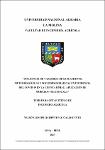Mostrar el registro sencillo del ítem
Influencia de variables de saneamiento, meteorológicas y sociodemográficas en incidencia del covid-19 en la cuenca Rímac: aplicación de modelos multiescala
| dc.contributor.advisor | Ramos Fernández, Lía | |
| dc.contributor.advisor | Vergara Villarino, Kerlim Arturo | |
| dc.contributor.author | Quispetupac Callocunto, Nelsón Joseph | |
| dc.date.accessioned | 2023-08-22T21:22:26Z | |
| dc.date.available | 2023-08-22T21:22:26Z | |
| dc.date.issued | 2023 | |
| dc.identifier.uri | https://hdl.handle.net/20.500.12996/5930 | |
| dc.description | Universidad Nacional Agraria La Molina. Facultad de Ingeniería Agrícola. Departamento Académico de Recursos Hídricos | es_PE |
| dc.description.abstract | La pandemia generada por la COVID-19 marcó un hito sin precedentes sobre el impacto de una enfermedad en el desarrollo mundial. Por ello este estudio analizó la relación de un grupo de variables sociodemográficas, metereológicas y de saneamiento en la cuenca del río Rímac con la propagación del virus. Sin embargo, algunas variables relacionadas directamente al distanciamiento social, el uso de mascarillas, disponibilidad de oxígeno, entre otras no fueron utilizadas debido a la falta de información. Además, el periodo de estudio fue en la primera ola de contagios, evidenciándose la falta de prevención, deficiencias en el sistema de salud, escasez de oxígeno, incumplimiento de restricciones por parte de la población, entre otras falencias que ayudaron a la propagación del virus. Por lo tanto, la aplicación y parametrización de modelos locales como la Regresión Ponderada Geográficamente (GWR) y Regresión Multiescala Ponderada Geográficamente (MGWR), permitieron inferir los posibles efectos de las variables mencionadas con la tasa de incidencia de la COVID-19. Respecto a la parametrización se utilizó el modelo global de Mínimos Cuadrados Ordinarios (MCO) cuyo objetivo fue obtener la combinación de variables significativas, encontrándose varios conjuntos, donde la variable densidad habitantes por kilómetro cuadrado (Densidad) fue una de las más relevantes. Asimismo, los resultados evidenciaron que el mejor ajuste se dio con el MGWR en todos los meses con el R2 más alto y menores valores en el criterio de información de akaike (AIC) seguido por el GWR y por último el MCO. Con estos resultados se propuso escenarios de propagación respecto a la variación porcentual de la variable Densidad en los distritos, de los cuales Breña fue el más afectado con un posible aumento de 8,9 unidades en la tasa de incidencia a nivel distrital, cuando se da una variación de 1 por ciento en la variable Densidad. | es_PE |
| dc.description.abstract | The pandemic generated by COVID-19 marked an unprecedented milestone in the impact of a disease on global development. For this reason, this study analyzed the relationship of a group of sociodemographic, meteorological and sanitation variables in the Rímac river basin with the spread of the virus. However, some variables directly related to social distancing, the use of masks, oxygen availability, among others, were not used due to a lack of information. In addition, the study period was in the first wave of infections, evidencing the lack of prevention, deficiencies in the health system, oxygen shortage, non-compliance with restrictions by the population, among other shortcomings that helped the spread of the virus. Therefore, the application and parameterization of local models such as Geographically Weighted Regression (GWR) and Geographically Weighted Multiscale Regression (MGWR), allowed us to infer the possible effects of the aforementioned variables with the incidence rate of COVID-19. Regarding the parameterization, the global model of Ordinary Least Squares (OLS) was used, whose objective was to obtain the combination of significant variables, finding several sets, where the variable density of inhabitants per square kilometer (Density) was one of the most relevant. Likewise, the results showed that the best adjustment occurred with the MGWR in all months with the highest R2 and lower values in the akaike information criterion (AIC) followed by the GWR and finally the MCO. With these results, propagation scenarios were proposed with respect to the percentage variation of the variable Density in the districts, of which Breña was the most affected with a possible increase of 8.9 units in the incidence rate at the district level, when given a variation of 1 percent in the variable Density. | es_PE |
| dc.format | application/pdf | es_PE |
| dc.language.iso | spa | es_PE |
| dc.publisher | Universidad Nacional Agraria La Molina | es_PE |
| dc.rights | info:eu-repo/semantics/embargoedAccess | es_PE |
| dc.rights.uri | https://creativecommons.org/licenses/by-nc-sa/4.0/ | es_PE |
| dc.subject | Análisis espacial | es_PE |
| dc.title | Influencia de variables de saneamiento, meteorológicas y sociodemográficas en incidencia del covid-19 en la cuenca Rímac: aplicación de modelos multiescala | es_PE |
| dc.type | info:eu-repo/semantics/bachelorThesis | es_PE |
| thesis.degree.discipline | Ingeniería Agrícola | es_PE |
| thesis.degree.grantor | Universidad Nacional Agraria La Molina. Facultad de Ingeniería Agrícola | es_PE |
| thesis.degree.name | Ingeniero Agrícola | es_PE |
| dc.subject.ocde | https://purl.org/pe-repo/ocde/ford#3.03.08 | es_PE |
| renati.author.dni | 47391176 | es_PE |
| dc.publisher.country | PE | es_PE |
| dc.type.version | info:eu-repo/semantics/publishedVersion | es_PE |
| dc.date.embargoEnd | 2025-07-18 | |
| renati.advisor.orcid | https://orcid.org/0000-0003-3946-7188 | es_PE |
| renati.advisor.orcid | https://orcid.org/0000-0002-1671-8047 | es_PE |
| renati.advisor.dni | 07462206 | es_PE |
| renati.advisor.dni | 40453916 | es_PE |
| renati.type | https://purl.org/pe-repo/renati/type#tesis | es_PE |
| renati.level | https://purl.org/pe-repo/renati/level#tituloProfesional | es_PE |
| renati.discipline | 811096 | es_PE |
| renati.juror | Chávarri Velarde, Eduardo Abraham | |
| renati.juror | Miglio Toledo de Rodriguez, Rosa María | |
| renati.juror | Ramos Taipe, Cayo Leonidas |
Ficheros en el ítem
Este ítem aparece en la(s) siguiente(s) colección(ones)
-
IAG-RH Tesis [310]





